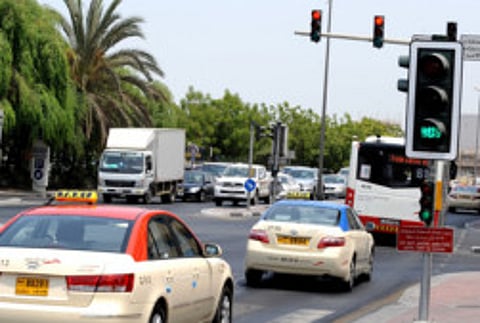Smart signals to help ease traffic in Dubai
408 traffic lights in Dubai connected to traffic control centre

Dubai: More traffic lights in Dubai have been connected with the smart traffic system that will help ease traffic movement at busy junctions.
The Roads and Transport Authority (RTA) has announced that 408 signalised traffic junctions have been linked to SCOOT, which is a traffic control system equipped with smart sensors to detect the volume of traffic on roads and ensure movement accordingly.
The system will ensure changes to traffic light sequences based on volume of traffic at a particular junction.
“SCOOT uses a series of detectors buried in the road surface to measure the traffic flow and a central computer then uses this data to vary the signal timings in real time to improve the progression of traffic through the network and reduce congestion,” said Maitha Bin Udai, CEO of RTA’s Traffic and Roads Agency.
She added that priority at the signals is given to the main traffic routes and the SCOOT system will work to aid progression on these routes while also trying to balance the demands of traffic on minor roads joining the junction.
This does mean that some approaches at signals will get less green time than others.
The system ensures the signal sequence at each set of traffic lights is decided based on computer modelling using measured traffic flows.
“This allows a number of different options to be evaluated and the best sequence selected. Sometimes a site may have specific safety considerations which may influence the stage sequence,” she added.
Traffic lights have been linked to SCOOT using wireless technology, while 3G technology has also been used in remote areas.
“The project is part of Dubai Government’s initiative to transform Dubai into a smart city. It involves replacing the cables used in linking light signals with the Traffic Control Centre in Dubai by a wireless network, besides linking isolated signals with the centre using 3G technology,” Maitha said.
She said that the new system eliminates the lag in the timing of traffic lights, while it is also more efficient and cost-efficient compared to the previous system, which required an intensive infrastructure in terms of cables and telephone lines to run the service at each signal.
SCOOT also reduces the risk of loss in connectivity which could result in traffic light malfunction, causing traffic jams.
“Benefits of the new system include remotely controlling the timing of light signals and managing them to cope with the changes in the traffic flow, which translates into low congestion at junctions,” she stated.
The system also enables diagnosing, managing and synchronisation of the timing remotely.
Sign up for the Daily Briefing
Get the latest news and updates straight to your inbox


